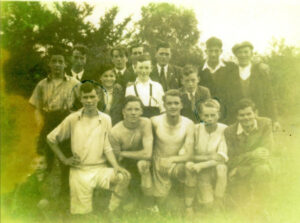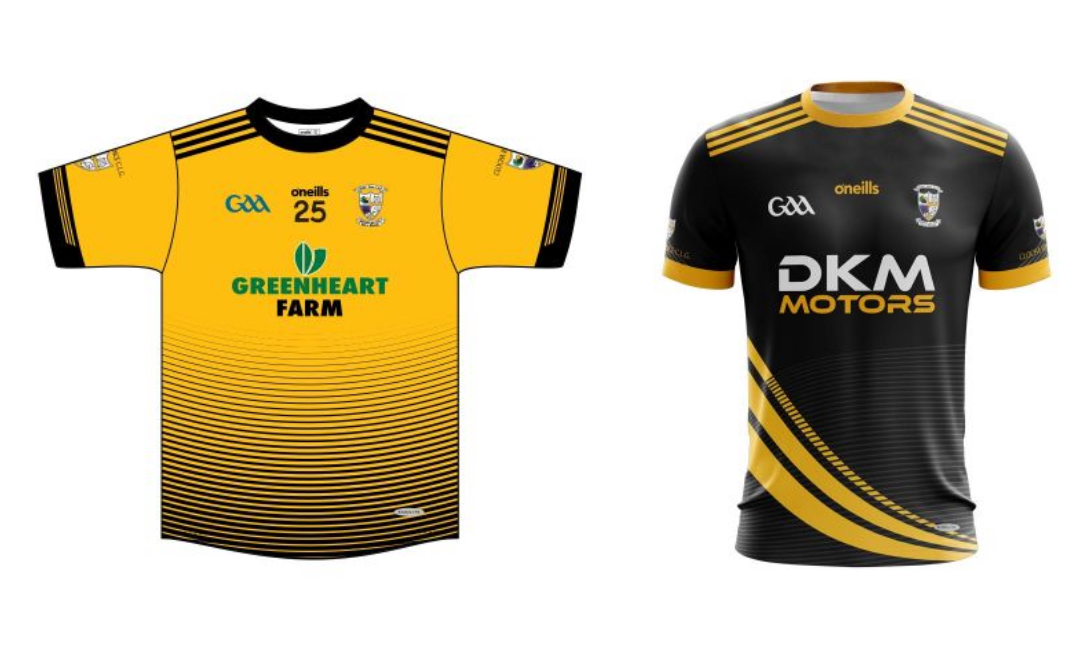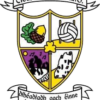The origins of Clogherinkoe GFC
by Ollie Conlan
The origins of the Clogherinkoe GAA club, like many GAA clubs in the country, can be traced back to the late nineteenth century. The foundation of this club and indeed the GAA as an organisation cannot be discussed without mentioning the wider historical context.
A wave of cultural nationalism swept Ireland in the mid nineteenth century, originating in the pre-famine ‘Young Ireland’ movement. This political, social and cultural group had, amongst other ideals, a determination to halt the erosion of Irish culture and to revitalise it. This movement was of course also inspired by nationalist activities and revolutions on the continent at the time. While the ‘Young Ireland’ rebellion of July 1848 was to end in failure, the establishment of The Nation newspaper some years previously, in 1842, was a crucial development. The Nation, established by Thomas Davis, Charles Gavan Duffy and John Blake Dillon was to become a major influence in nationalist thinking. Michael Doheny, a contemporary of Thomas Davis, wrote of him:
In speech, article, song and essay the spell of Davis’ extraordinary genius and embracing love was felt. Historic memories, forgotten stories, fragments of tradition……supplied him substance and spirit wherewith to mould and animate nationality…. All that had a tendency to elevate and ennoble he rescued from the past to infuse into the future.
Davis believed in building a nation that transcended religious and ethnic differences through the Irish culture. In recognising the importance of the native language in creating a national identity, he stated:
to lose your native tongue and learn that of an alien is the worst badge of conquest – it is the chain on the soul
The Irish language unfortunately declined considerably in the post-famine period, and in an effort to halt the decline the society for the preservation of the Irish language was formed in 1877, culminating in the foundation of the Gaelic league in 1893.
In keeping with the the resurgence of nationalist feeling, the GAA was founded by Michael Cusack in 1884. Its ideals were to promote Irish games that were ‘racy of the soil’ such as gaelic football, hurling, handball and rounders as an alternative to English games, for example, cricket, tennis, polo, etc. Archbishop Croke, Michael Davitt and Charles Stewart Parnell became the first patrons of the association.
On the occasion of the GAA’s Golden Jubilee in 1934, Cardinal MacRory, Archbishop of Armagh wrote an article in the Irish Press Newspaper describing the GAA’s impact on Irish life. Cardinal MacRory wrote:
Before the founding of the GAA, language, music and dances were fast disappearing and only the dry bones of Irish nationalism remained. The GAA clothed these dry bones with flesh and quickened them with a vigorous pulsating life.
Following the foundation of the GAA various clubs sprang up throughout the country and many of these clubs were named after iconic nationalist figures such as Patrick Sarsfield, Theobald Wolfe Tone, Robert Emmet and of course Thomas Davis. This was perhaps a good example of the self-confidence that was evident in Irish nationalism at the time. It is no surprise that the first club in this locality was named after another iconic figure, Eoghan Ruadh [Owen Roe] O’Neill. This man had come back from the continent to become quite a successful leader in the 1641 rebellion. It is unlikely that O’Neill had any connection with this area except for being commemorated in song and story. The celebrated nationalist poet Aubrey De Vere immortalised O’Neill in verse, which contained the lines
Owen Roe our own O’Neill-
he treads once more our land!
the sword in his hand is of Spanish steel,
but the hand is an Irish hand!
The Eoghan Ruadh O’Neill team was selected from the Broadford and Clogherinkoe areas similar to the present Clogherinkoe team today. They played the majority of their matches locally, as this was prior to there being any sort of organised championship. Johnny Reilly from Renehan often brought the team to matches on a horse drawn hackney cart. Flannagan’s field in Clogherinkoe was their primary pitch.
This photograph is believed to have been taken in 1904 by Phil O’Connor of Harristown.

Front (L-R): Jim Whelehan, Jack Coyne, Paddy Coyne, Tom Conlan
Middle (L-R): An Other, Jim Connolly, Tom Beatty (Capt), Pat Conlan, An Other, Dan Beegan,
Back (L-R): Hugh Mooney, Jim Dunne, Tom Loughrey, Jonnie Conlan, Paddy Whelehan, Pat Molloy, Larry Hickey
There is a unique photograph of this team dating from 1904 on the clubhouse wall. Phil O’Connor from Harristown is believed to have been the photographer and many of the names mentioned on that photograph are still prominent in the area today. It is not known when the team disbanded, however, it appears to have later competed as a Carrick selection for some years.
The next team to be formed in the locality was the Ballindoolin team which came into existence in 1937. Tom Conlan and Joe Hickey collected 6d. each from interested locals to raise the eighteen shillings needed to buy a ball. Initially the team played in Ned Kelly’s field in Ballindoolin, later relocating to Jack Flynn’s field in Williamstown. Some of the players included Joe Hickey, Noel Crinnigan, Willie Hickey, Mick McDonald, Donal Hoey, Sean Egan, Peter, Tom and P [Patrick] Conlan, Sean Moore, Willie & Jimmy (Boiler) Tyrrell, Willie Tyrrell (from Highfield), Joe, Jimmy, Peter and John Donoghue, Pal Mooney, Micky and Arthur Williams, Mick and Sean Delaney, Alex Sutton, Hugh Mooney, Martin Meleady, Tom Lynch, Steve Miggin, Luke Murray and a Kerryman Tim Begley.
Ballindoolin played primarily against local teams like Carbury, Cappagh and their main rival Mucklon. The Mucklon team consisted of bog workers from the local Mucklon Camp. These camps were set up to supply turf to Dublin during the war years in response to the fuel shortage. The camps consisted of men from all over Ireland and predominantly from the west. It was Mucklon that provided one well known encounter that took three matches to decide. The first two games of the series resulted in draws. The third and final game resulted in a one point victory to Mucklon.
The Ballindoolin jerseys were red with white trim which was fairly close to the Edenderry strip. During the war years Ballindoolin found it difficult to field a team due to a lack of transport and available players. This allowed, on occasion, for the Jerseys to be loaned to Edenderry.
The Ballindoolin team disbanded around 1949 and the Clogherinkoe team was founded soon after, one Sunday in 1954.
On the day the team got started, a large group of local lads gathered at the site of Bernie Leonard’s house and made up two teams (8 or 9 a side). Jim Walsh refereed the match and Jasper Tyrrell played in goal. After the game Jasper Tyrrell put his hand in his pocket, pulled out a big English five pound note and handed it to Sean Delaney as a contribution to start a team. Two shillings per person was collected outside the chapel to accumulate the price of a ball.
Some of the players that were involved in the Ballindoolin team formed the nucleus of the new Clogherinkoe team and P. Conlan was elected to the chair. Upon Clogherinkoe GFC’s formation, they petitioned Edenderry for the return of the old Ballindoolin jerseys. Edenderry declined the request and, as an alternative, offered Clogherinkoe a choice of replacement jerseys, which were originally Local Defence Force uniforms. The choices were blue with white hoops or black and amber. Clogherinkoe chose the black and amber strip which they still wear proudly today.
Paddy Delaney was the first captain of the Clogherinkoe team. Paddy was such a key player that when he relocated to Naas, two local boys would ride their motorbikes over to Naas to fetch Paddy and his wife so that Paddy could still play.
The newly formed Clogherinkoe team did not play in the championship in 1954. Their first championship match was in 1955 with a loss to Eire Og. In the 1956 Championship, Clogherinkoe were eliminated by Straffan.
In 1957, however, things went a little differently. In the first round of the ‘57 championship, they played Kilcock at Farrelly’s field in Broadford. Kilcock were well beaten that day. In the aftermath, Davey Doran, the team manager, was asked how the team would fare that year. He confidently responded ‘I’ll see you in Newbridge at the end of the year.’
And this is exactly how it turned out because Clogherinkoe subsequently defeated Straffan and went on to win the Junior B Championship, beating Round Towers in a replayed final. As a side note, Round Towers and Clogherinkoe both wore the same colours. A coin toss was held to see who would wear an alternative strip and Clogherinkoe lost. For the final, the Cloghs wore white uniforms loaned to them by Nurney.
Noel Sutton was the Clogherinkoe captain in 1957 but was out injured for the final. At that time, the team had seventeen players and only fifteen jerseys, so when a substitution was made, the lad coming from the field would whip off his jersey and hand it to his replacement.
While Clogherinkoe also won the league in 1957, they didn’t have everything their own way that year. They were handily beaten by Castledermot in the Higgins Cup in a match that has been described as ‘feisty’ and ‘controversial’. A couple of the Cloghs lads were sent off that day.
In 1958, Clogherinkoe moved up to Junior A. Around that time they played many seven a side tournaments. One particularly memorable contest is worth a mention. Played in Edenderry, the Clogherinkoe boys took a lead into the half time break. Their opponents, none too pleased with some of the referee’s decisions, attempted to chase him down to ‘discuss’ things. Upon seeing that the lads intending to question him were bringing a hurl to the discussion, the referee took off. The replacement referee was very familiar to the Cloghs as he had officiated their 1957 Higgins Cup final. Clogherinkoe defiantly refused to take the field for the second half and the match was never finished.
In 1963 Clogherinkoe beat Straffan in the final to win the Junior A Championship.
Clogherinkoe’s first ‘breakthrough’ into the Kildare Senior team was Pat Tyrrell. Of course many players from the club were to don the white jersey in all grades afterwards right up to the present day. More silverware was to follow too, including the Sydney Weld trophy for the Junior C Championship in 1977. This trophy was named in honor of a county board official who also played for the above mentioned Carrick team while he was working locally. Clogherinkoe went on to defeat the Junior B champions, Clane, giving them another tilt at the Higgins Cup where unfortunately they lost out to Suncroft.

This photograph was taken in 1954 of some of the lads that were interested in getting a team up and running again.
Front (L-R): Jim Leonard, Paddy Delaney, Peter Delaney, Dick Leonard, Jimmy Donohue
Middle (L-R): Ernie Lawless, Mattie Kerrigan, Danny Kelly, Seamus O’Connor
Back (L-R): Jim Kane, Dan Kane, Pauric McWillan, Paddy Flynn, Jonny Flynn, Paddy Kelly
Child at Front: Billy Delaney
The club purchased its own field in conjunction with the Broadford hurling club in 1980. The field was officially opened in 1984 and an outdoor Mass was offered by the local curate Rev. E. Flood who incidentally went on to manage the team to another championship success that year. It is important to ‘speak of ‘98’ also, when after another championship win, this team went on to finally capture the Higgin’s cup at the fifth attempt.
In 2012 the club was successful in securing the Kildare Junior A championship for a fourth time. In 2020 the Cloghs managed to secure an Intermediate Championship. It was a strange affair with Covid regulations dictating a limit on numbers in attendance. The Hugh Campion Cup was proudly brought around the Parish. The present team have their sights firmly set on the elusive Senior title and hopes are high that this can be achieved in the not too distant future
Of course this team, just like the teams before them would not have able to function were it not for the wide-ranging support base that was provided to the various selections through the years. Every club has the unsung heroes quietly working (maybe not on match day!) to keep the club functioning and progressing. The parents, grand-parents, children, supporters and sponsors are also pivotal to the survival of this club and are always there to encourage and support the players. If Michael Cusack and the six other men that that attended that historic meeting in Thurles, on November 1, 1884 were alive today they would probably say that the GAA as an organisation had developed beyond their wildest dreams.
Thomas Davis would probably be dissappointed at the overall decline of the Irish language, however, on the inclusive ‘spirit of nationhood’ that the GAA has espoused he would most likely feel justifiably proud and fulfilled. The Clogherinkoe club is in an equally healthy situation and looking forward to a bright future with an abundance of young talent coming through the ranks. Finally, and in grateful appreciation, much of the information included in this article was gleaned from consultations with former players and loyal supporters such as, Hugh Mooney, Peter Conlan, Peter and Tommy Delaney, Bernie Leonard and Johnny McCabe.




